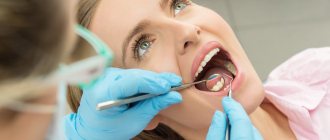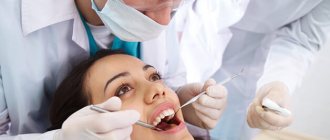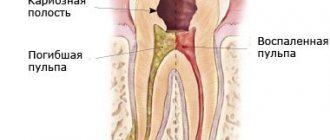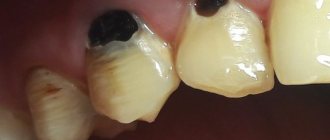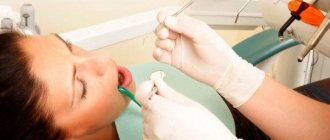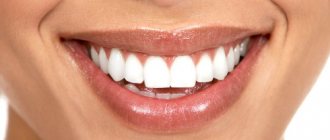Important information about diseases and factors that cause blue gums in adults
When blue gums near a tooth are discovered, or generalized (along the entire row) changes in the shade of the oral mucosa become noticeable, then there is no time for jokes. Many are beginning to wonder what this might be connected with. And we will tell you about the most common – dangerous and not very compelling reasons for this phenomenon.
The reasons for blue gums can be different.
Possible dental causes
Some dental patients notice that they have blue gums after tooth extraction. Indeed, this is not uncommon. Often the phenomenon is caused by traumatic effects on tissues, vessels and capillaries during surgical procedures. And such a symptom may not necessarily occur only after root removal, but also after procedures such as anesthesia, incisions, suturing, and gum retraction. Changes in mucosal swelling can often be seen after the following operations: gingivectomy, vestibuloplasty, osteoplastic procedures, implant installation.
Important! After surgery, blue gums in an adult are most often discovered due to too large-scale intervention or traumatic actions of the doctor. And also if the patient has a history of various chronic diseases, for example, hypertension, diabetes, or poor blood clotting. In this case, there is a high risk of hemorrhages in the tissue and the formation of various hematomas.
If there is blue gum near a tooth, this may be due to other dental factors:
- poor-quality prosthetics: after installing structures that do not correspond to the anatomical characteristics of the patient, or are too “driven” under the gums, hematomas may form, since the tissues are compressed too much and cease to be properly supplied with blood,
- the presence of crowns with a metal component in the mouth: materials based on alloys of base metals can, over time, interact with saliva and oxidize, leaving blue gum above or below the tooth. Blue gums can even appear from a metal-ceramic crown,
Gums may remain blue after whitening
- teeth whitening carried out by an inexperienced dentist, cosmetologist, or, more often, by the patient himself (for example, at home, using inappropriate means and folk recipes). In the process, a doctor or home “experimenter” may leave soft tissues without proper protection, apply too much product and not remove the excess, overexpose the composition and thereby provoke a burn,
- inflammatory periodontal diseases: gingivitis, periodontitis and periodontal disease,
- purulent processes in the affected teeth, mucous membrane, bone tissue: for example, gumboil, enlarged cyst or granuloma, abscess, osteomyelitis,
- the presence of removable dentures in the mouth: at the initial stage, they can put pressure on the mucous membranes, injure and irritate them, and impair blood circulation in the tissues. During operation, such problems arise in the absence of timely corrections and against the background of inevitable atrophy of the jaw bone,
- complications after surgical interventions: for example, alveolitis after tooth extraction. This may also be inflammation of the tissue around the implant, indicating mucositis or peri-implantitis,
- cervical caries.
“5 years after wearing a metal-ceramic bridge, my gums became blue, and they become exposed when I smile. It was very ugly. After that, she stopped opening her mouth wide at all. She hardly smiled. Complexed. And when the bridge cracked a few years later, the dentist suggested replacing it with zirconium dioxide so that there would be no blue discoloration. It cost me a lot more, but now everything looks very natural and doesn’t interfere with my smile.”
Marina Olegovna, review from the dental portal gidpozubam.ru
Blue gums after installation of metal-ceramic crowns
What can cause your gums to turn blue?
So, why can individual areas of the gums change their color, and where do such blue spots appear on the mucous membrane? This could be due to many different factors. So, for example, if we are talking about a child, the reason may be the eruption or change of baby teeth. In adults, a similar symptom is sometimes provoked by certain diseases of periodontal tissue or the oral mucosa as a whole. Also, the area near the tooth may turn blue due to unsuccessful prosthetics or malfunctions in the internal systems of the body. Let's look at possible provoking factors in more detail.
Why do my gums turn blue?
Causes of blue gums in a child
The time when a baby's first teeth emerge varies in each situation individually. When an already formed rudiment erupts, inevitable injury to soft tissues occurs, and, as is known, a large number of vessels are concentrated in them. Due to a violation of the integrity of the mucous membrane, blood enters the soft tissues, and a hematoma forms. If the child is one year old and a bruise appears on his gum, namely in the place where the tooth should appear, there is nothing to worry about.
“And sometimes the teeth start to break through with a bruise. We had the same thing with the side ones. I remember looking in the morning and a blue spot appeared on my daughter’s gum. I thought that she had hit herself somewhere, so I decided to observe. And after a while a white stripe appeared.”
Marina7, Irkutsk, from correspondence on the woman.ru forum
Among the pathological causes of the formation of blue areas in the mouth in children, experts in the field of pediatric dentistry and pediatrics identify the following conditions:
- inflammation of gum and periodontal tissues: the most common cause of blue discoloration is gingivitis - inflammatory processes that spread in the gums without disrupting the periodontal attachment. Redness turning blue is observed in localized areas, mainly in the cervical area. At the same time, the child becomes whiny and capricious, and his appetite is impaired. If left untreated, the next stage may be periodontitis,
Gingivitis in a child can cause blue gums - diseases of the mucous membrane: often stomatitis leads to blue gums - an inflammatory disease, the development of which is accompanied by the appearance of painful rashes on the gums, the inside of the cheeks, lips, palate and tongue. In this case, a change in the color of the soft tissues is noted around the tumors. Associated symptoms include severe pain in the oral cavity, as well as a sharp increase in body temperature.
Stomatitis is common in infants
It is worth noting that most often the diseases described above are diagnosed in children with weakened immune defenses. However, the main enemy of oral health is poor oral hygiene. Plaque and dental deposits are the key cause of most dental ailments.
Why does the mucous membrane turn blue in adults?
In adults, the gums most often turn blue after poor-quality dental intervention, as well as against the background of periodontal diseases and systemic pathologies of the body as a whole. Thus, the most common cause of hematoma is unsuccessful prosthetics. A small blue spot may appear above the crown if it is pushed too far under the gum. As a result, microcirculation will be disrupted, a blood clot will form, swelling and hypoxia of the mucosa will appear. Much less often, a similar situation occurs during restoration with filling materials, when the composite is carelessly applied to the gum1.
On a note! There is an opinion that the soft tissues surrounding the structure may turn blue due to metal-ceramics. This is a common misconception based on the assumption that the metal is oxidizing. In fact, changes in the gums around the crown only indicate its incorrect installation. The metal in the crown does not oxidize and certainly does not rust. To create such orthopedic structures, a special alloy is used, which fully meets all the necessary requirements.
In some cases, darkening of gum areas may indicate the development of certain pathological conditions of internal organs and systems. These include the following factors:
- thin blood vessel walls or blood clotting problems,
- violation of microcirculation,
- gingivitis and periodontitis,
- deficiency of vitamins and microelements in the body,
- anemia.
Blue gums in adults may occur after the installation of crowns.
In the case of anemia, a lack of iron, vitamin B12 and other vital substances in the body leads to a decrease in the level of hemoglobin in red blood cells. As a result, the patient experiences pallor of the skin and mucous membranes, including the appearance of cyanosis.
What internal diseases may the symptom indicate?
If you have blue gums, then the reason for this phenomenon is pathological changes occurring in the body against the background of various systemic diseases. Thus, due to diseases of the blood, heart, and metabolic disorders, blood vessels become thinner and capillaries become fragile, and internal local bleeding occurs.
Doctors say that a similar symptom sometimes occurs against the background of iron deficiency conditions, that is, with anemia. For kidney disease and thyroid problems. And in diabetes mellitus, when the processes of nutrition and tissue regeneration are disrupted, even minor traumatic injury can lead to the formation of long-term non-healing hematomas.
Why does the gum move away from the tooth?
A prerequisite for the destruction of the periodontal attachment is the presence around the necks of the teeth - soft microbial plaque or supragingival tartar. The formation of dental plaque occurs due to irregular oral hygiene. In some patients with periodontitis, tartar may not be visually visible, because... when the attachment of the gum to the tooth is destroyed, it can already be localized below the level of the gum (then it is called “subgingival”).
But usually the destruction of the attachment of the gums to the teeth is always preceded by a long period of chronic inflammation of the gums, during which the patient is only bothered by periodic bleeding of the gums, possibly bad breath, redness or cyanosis of the gingival margin, as well as swelling of the gingival papillae. These symptoms are characteristic of gingivitis, an inflammatory disease of the gums in which the attachment of the gum to the tooth is not yet broken.
The lack of professional treatment for gingivitis (usually patients during this period self-medicate using antiseptic rinses and toothpastes for bleeding gums) leads to destruction of the attachment of the gums to the teeth. As a result, so-called periodontal pockets (gingival pockets) are formed between the teeth and gums, and patients in this case may complain that their gums have moved away from their teeth.
Stages of gum inflammation (gingivitis and periodontitis) –
Conclusions: Figure 10 shows the differences between gingivitis and periodontitis, and that with periodontitis, the gums are not attached to the teeth to the full depth of the periodontal pockets (from 3 to 6 mm or more). Therefore, if your gum has moved away from a tooth, there is simply no point in delaying a visit to the dentist, unless, of course, your goal is to remove these teeth in the near future. And in this case, there is no method of self-medication (magic rinses or ointments for gums) that would allow you to save the situation without going to the dentist.
In the absence of professional treatment of gums by a dentist, such teeth will first become mobile, then they will begin to fan-shaped and shift in different directions (under the forces of chewing pressure). In Fig. 11-13 you can see advanced forms of periodontitis in patients who, unfortunately, turned to the dentist too late. The teeth in these photographs have a very high degree of mobility and many of them only need to be removed.
Consequences of lack of treatment -
Other factors leading to the problem
Another reason why an adult’s gums may turn blue is a burn. It is not difficult to get it if you eat too spicy foods, hot soups and sour drinks. A bad habit such as smoking can also contribute to this.
The symptom may indicate chemical burns, when delicate tissues are damaged due to the use of aggressive compounds unsuitable for the oral cavity. For example, alcohol, manganese, iodine, peroxide.
Very often, pathology occurs due to bruises and injuries received in the area of the maxillofacial apparatus. And the safest reason that can explain the blueness of mucous membranes is the consumption of drinks and dishes with food or natural dyes that give pigment to the teeth, gums and tongue. For example, blueberries, blackberries, soda pop, plum wine and plums. Fortunately, you can easily get rid of this problem by thoroughly cleaning your mouth with a brush and paste.
What tactics are used to treat periodontal disease?
I want to start with the fact that patients who come with a diagnosis of periodontal disease, they need, every single one, treatment... not from the periodontist to whom they initially turned.
If we talk about the tactics of managing patients with the so-called. periodontal disease, which then come to me again, it’s a shame to voice this, but the treatment of periodontal disease was carried out right up to injections of Lincomycin into the exposed gum.
According to statistics, almost always the treatment of periodontal disease in adults with medications is burdened with a course of some antibiotics and physical therapy.
And most importantly, the task of all these manipulations is completely unclear: what do doctors want to achieve in this way, to destroy some kind of flora or to stop some destructive processes in the gums? It is very difficult for me to say what happens to the competence of a doctor who injects antibiotics for the so-called. periodontal disease, but this is absolute blasphemy. Is it possible to cure periodontal disease by destroying the flora? As a result, the gums will never recover.
Treatment of gum periodontal disease reaches the point of absurdity
I would like to note the widest range of drugs and folk remedies that patients use to attempt self-treatment of periodontal disease at home. Among the folk remedies, one can note the treatment of periodontal disease with hydrogen peroxide, and even treatment with soda:
What about the use of various toothpastes for periodontal disease? What goals do patients have? The purpose of toothpaste is preventative, not curative. And no toothpaste will eliminate inflammation, because there is no such inflammation in periodontal disease.
It is not difficult to guess that in these combinations of procedures the question of how to cure periodontal disease remains open.
Possible associated symptoms
Typically, blue gum above or below a tooth is not the only symptom that something is wrong. Typically, people with a similar problem note other warning signs:
- mucous membranes swell and begin to bleed, may move away from the necks of the teeth,
- itching and soreness in the gums occurs: the discomfort intensifies with pressure, any mechanical impact, while eating food,
- a nearby tooth hurts, it can also become mobile,
- body temperature rises,
- there is a strong foul odor coming from under the gums, pus may be released,
- Plaque intensively accumulates on the necks of teeth.
Forms of gingivitis and symptoms
Signs of gingivitis directly depend on the nature of the disease and its form. Let's look at each form of gingivitis separately. So, complaints and visual inspection.
Catarrhal gingivitis
This form of the disease usually occurs without obvious pain. Its immediate symptom is bleeding gums when brushing teeth, eating solid foods and other mechanical effects on the dental system.
Ulcerative-necrotizing gingivitis
This is one of the most unpleasant forms of gingivitis, which is characterized by a feeling of itching of the gingival papillae, severe pain, copious flow of saliva, fever, inflammation of the lymph nodes and the formation of necrotic areas of the gums.
Hypertrophic gingivitis
Patients suffering from this form of gingivitis complain of severe pain, constant bleeding of the gums and a significant increase in the volume of the gums, which can partially cover the crowns of the teeth from the outside (not from the tongue). At the same time, the patient’s gum remains quite hard and under it, on the teeth, tartar forms, which creates favorable conditions for the proliferation of microorganisms. With hypertrophic gingivitis, teeth may move slightly.
Atrophic gingivitis
The last and most advanced stage of gingivitis, often leading to periodontitis, is atrophic gingivitis. With it, the gum tissue becomes thinner, decreases in size, the necks of the teeth, and sometimes their roots, are exposed. Teeth become more sensitive to temperature changes (cold or hot drinks, frosty air), to sour or sweet foods, to the mechanical impact of a toothbrush.
Desquamative (geographic) gingivitis
The symptoms of this form of gingivitis differ from others by pronounced red spots on the gums, desquamation of the upper layer of the epithelium, the appearance of blisters on the gums and the formation of mouth ulcers and erosions.
When does it make sense to go to the doctor?
Of course, in any unclear situation this will be the best solution. However, many people prefer to wait a few days, observe the condition of their blue gums and evaluate their overall health. And this is not prohibited if you do not have a rapid increase in body temperature and positive dynamics are observed.
In what cases should you urgently consult a doctor?
In cases where blue gums persist for longer than 3-5 days, with severe pain, high fever, loss of appetite, a change from a local process (when the gums turn blue in the area of 1 tooth) to a generalized one (the pathology spreads to neighboring elements of the row, increases in size, grows ) you should consult a doctor as soon as possible.
When is it time to go to the doctor?
If a blue spot appears on the mucous membrane, it is better to see a doctor immediately. However, it is not always possible to urgently contact a specialist. Therefore, you need to know exactly when you can’t postpone a visit to the dentist. So, you need to seek help urgently if you have the following symptoms:
- the stain remains on the mucous membrane for more than 3 days,
- hyperthermia with signs of fever is noted,
- the patient complains of severe pain in the gums,
- general condition worsens, appetite is impaired.
A timely visit to the dentist will help to avoid the problem.
A problem that is not resolved in a timely manner significantly increases the risk of developing serious complications. Among these are possible suppuration, the appearance of a benign tumor and the formation of a cyst.
What can dentists offer in the fight against gum pathologies?
When a person discovers blue gums, he probably asks the question: what to do? The first step is to see a dentist. The doctor will examine your mouth and identify possible problems.
If the cause is poor-quality or incorrectly installed crowns or dentures, they will need to be adjusted or replaced. In case of dental diseases and detection of purulent processes against this background, it may be necessary to open, drainage and antiseptic treatment of tumors, clean the root canals, apply medicated pads and install a sealed filling at the end.
In case of periodontal inflammation, a specialist will definitely prescribe comprehensive treatment[1]. It is aimed at eliminating symptoms, restoring gum tissue and preserving teeth, which, in advanced stages of periodontitis and periodontal disease, can become loose and fall out. What procedures will be required: professional oral hygiene to remove bacterial plaque, anti-inflammatory and restorative therapy for gums in the form of rinses, lotions, antibiotic therapy. Some patients are also prescribed plasma lifting and periodontal gels with growth factors.
Expert opinion
Marina Igorevna Tarabanovskaya
Specializations: Dentist-therapist, periodontist
Experience: 10+
“In case of periodontal diseases, it is important not only to undergo treatment, but also to adjust the lifestyle that the patient usually leads. It is necessary to follow a certain diet, stop smoking, and purchase a suitable brush, toothpaste and mouthwash for daily hygiene. And be sure to undergo professional hygiene and examination by a dentist at least twice a year. Otherwise, the pathology will constantly worsen, and the patient risks losing all his natural teeth ahead of time.”
Treatment of blue gums
When the gums turn blue, the dentist carries out the following diagnostic measures:
- facial configuration analysis;
- examination of the oral cavity;
- taking a targeted x-ray of a nearby tooth;
- orthopantomogram;
- biopsy;
- analysis for an immunohistochemical marker with the HMB antibody - 45.
Based on the cause of the blue gum, as well as the results of the diagnostic examination, the attending physician prescribes treatment.
For the eruption of primary and permanent teeth, as well as for bruises and chronic injuries, the following are prescribed:
- treatment of the inflamed area with anti-inflammatory and analgesic gels (Kalgel, Kholisal, Kamistad);
- intraoral baths with herbal preparations (infusion of chamomile, Rotokan, Stomatofit);
- rinsing the mouth with an aqueous solution of chlorhexidine 2-3 times a day.
The key to a quick recovery is to eliminate the cause of blue periodontal tissue. Removing overhanging fillings, correcting dentures and orthodontic structures will help cure inflammation in a short time.
Teething in children can be made easier by surgically cutting the gingival hood. This frees up the passage for the new tooth and reduces pain.
Gingivitis, periodontitis and other inflammatory diseases of the oral cavity are treated with anti-inflammatory therapy and strengthening the general immune system.
In addition to dental applications and rinses, professional oral hygiene is carried out using ultrasound. During the dental procedure, tartar and bacterial plaque, which are the causes of unpleasant periodontal symptoms, are removed.
It should be remembered that self-medication will only worsen the course of dental disease, therefore, if your gums turn blue, you need to consult a dentist for medical help as soon as possible.
